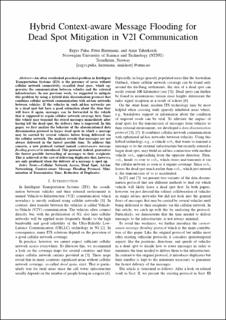| dc.contributor.author | Puka, Ergys | |
| dc.contributor.author | Herrmann, Peter | |
| dc.contributor.author | Taherkordi, Amirhosein | |
| dc.date.accessioned | 2021-03-04T11:58:13Z | |
| dc.date.available | 2021-03-04T11:58:13Z | |
| dc.date.created | 2021-02-27T00:21:42Z | |
| dc.date.issued | 2020 | |
| dc.identifier.citation | IEEE Vehicular Technology Conference (VTC). 2020, 92, . | en_US |
| dc.identifier.issn | 1090-3038 | |
| dc.identifier.uri | https://hdl.handle.net/11250/2731628 | |
| dc.description.abstract | An often overlooked practical problem in Intelligent Transportation Systems (ITS) is the presence of areas without cellular network connectivity, so-called dead spots, which aggravates the communication between vehicles and the external infrastructure. In our previous work, we suggested to mitigate this problem by using a hybrid data dissemination protocol that combines cellular network communication with ad-hoc networks between vehicles. If the vehicles in such ad-hoc networks are in a dead spot but have a good estimation about the time they will leave it again, messages can be forwarded to the vehicle that is supposed to regain cellular network coverage first. Since this vehicle may transmit the stored messages immediately after having left the dead spot, the delivery time is improved. In this paper, we first analyze the behavior of the aforementioned data dissemination protocol in larger dead spots in which a message may be carried by several vehicles before being delivered via the cellular network. The analysis reveals that messages are not always delivered in the fastest possible time. To address this concern, a new protocol variant named context-aware message flooding protocol is introduced. This protocol, indeed, guarantees the fastest possible forwarding of messages to their recipients. This is achieved at the cost of delivering duplicates that, however, are only produced when the delivery of a message is sped up. | en_US |
| dc.language.iso | eng | en_US |
| dc.publisher | Institute of Electrical and Electronics Engineers (IEEE) | en_US |
| dc.relation.uri | https://ieeexplore.ieee.org/document/9348721 | |
| dc.title | Hybrid Context-aware Message Flooding for Dead Spot Mitigation in V2I Communication | en_US |
| dc.type | Peer reviewed | en_US |
| dc.type | Journal article | en_US |
| dc.description.version | acceptedVersion | en_US |
| dc.source.journal | IEEE Vehicular Technology Conference (VTC) | en_US |
| dc.identifier.doi | 10.1109/VTC2020-Fall49728.2020.9348721 | |
| dc.identifier.cristin | 1894192 | |
| dc.description.localcode | © 2020 IEEE. Personal use of this material is permitted. Permission from IEEE must be obtained for all other uses, in any current or future media, including reprinting/republishing this material for advertising or promotional purposes, creating new collective works, for resale or redistribution to servers or lists, or reuse of any copyrighted component of this work in other works. | en_US |
| cristin.ispublished | true | |
| cristin.fulltext | postprint | |
| cristin.qualitycode | 1 | |
